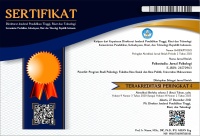Emotion Regulation Training Based on Cognitive Behavioral Therapy to Reduce Anxiety Levels in Adolescent
Abstract
Masalah kecemasan yang tidak ditangani berpotensi menimbulkan berbagai hambatan pada remaja, seperti kesulitan melakukan aktivitas sehari-hari, masalah dalam relasi sosial, kurangnya performa akademik dan berbagai persoalan lain yang lebih kompleks. Penelitian ini merupakan penelitian kuasi eksperimen dengan one-group pretest-posttest design yang bertujuan menguji efektivitas pelatihan regulasi emosi berbasis Cognitive Behavior Therapy (CBT) dalam menurunkan tingkat kecemasan pada remaja. Partisipan penelitian ini adalah 5 orang remaja perempuan (13-14 tahun) yang memiliki masalah kecemasan dan disregulasi emosi tingkat sedang hingga berat. Pelatihan dilakukan dalam 5 sesi dengan durasi 1-1,5 jam pada tiap pertemuan. Pengukuran dilakukan dengan Difficulties in Emotion Regulation Scale Short Form (DERS-SF) dan Depression Anxiety Stress Scales (DASS 21) untuk mengetahui perubahan tingkat disregulasi emosi dan kecemasan sebelum, setelah dan 3 pekan setelah pelatihan dilaksanakan. Hasil penelitian menunjukkan adanya penurunan disregulasi emosi (26,9%-30,5%) dan kecemasan (17,1%-42,8%) pada partisipan. Pelatihan regulasi emosi berbasis CBT efektif meningkatkan kemampuan mengelola emosi dan menurunkan tingkat kecemasan pada remaja. Pelatihan ini dapat dipertimbangkan sebagai salah satu metode intervensi kelompok guna mengatasi masalah kecemasan pada remaja.
Keywords
Full Text:
FULL TEXTReferences
Asnaani, A., Tyler, J., McCann, J., Brown, L., & Zang, Y. (2020). Anxiety sensitivity and emotion regulation as mechanisms of successful CBT outcome for anxiety-related disorders in a naturalistic treatment setting. Journal of Affective Disorders, 267. https://doi.org/10.1016/j.jad.2020.01.160
Bailen, N. H., Green, L. M., & Thompson, R. J. (2019). Understanding emotion in adolescents: A review of emotional frequency, intensity, instability, and clarity. Emotion Review, 11(1), 63–73.
Baker, R., Owens, M., Thomas, S., Whittlesea, A., Abbey, G., Gower, P., Tosunlar, L., Corrigan, E., & Thomas, P. W. (2012). Does CBT facilitate emotional processing? Behavioural and Cognitive Psychotherapy, 40(1). https://doi.org/10.1017/S1352465810000895
Berking, M., Wupperman, P., Reichardt, A., Pejic, T., Dippel, A., & Znoj, H. (2008). Emotion-regulation skills as a treatment target in psychotherapy. Behaviour Research and Therapy, 46(11). https://doi.org/10.1016/j.brat.2008.08.005
Blake, M. J., Trinder, J. A., & Allen, N. B. (2018). Mechanisms underlying the association between insomnia, anxiety, and depression in adolescence: implications for behavioral sleep interventions. Clinical Psychology Review, 63, 25–40.
Brans, K., van Mechelen, I., Rimé, B., & Verduyn, P. (2013). The relation between social sharing and the duration of emotional experience. Cognition and Emotion, 27(6). https://doi.org/10.1080/02699931.2012.762758
Burton, A. L., Brown, R., & Abbott, M. J. (2022). Overcoming difficulties in measuring emotional regulation: Assessing and comparing the psychometric properties of the DERS long and short forms. Cogent Psychology, 9(1). https://doi.org/10.1080/23311908.2022.2060629
Center for Reproductive Health, U. of Q. & J. B. H. S. of P. H. (2022). Indonesia – National Adolescent Mental Health Survey (I-NAMHS): Laporan Penelitian. Pusat Kesehatan Reproduksi.
Cisler, J. M., Olatunji, B. O., Feldner, M. T., & Forsyth, J. P. (2010). Emotion regulation and the anxiety disorders: An integrative review. In Journal of Psychopathology and Behavioral Assessment (Vol. 32, Issue 1). https://doi.org/10.1007/s10862-009-9161-1
Creswell, C., Waite, P., & Hudson, J. (2020). Practitioner Review: Anxiety disorders in children and young people – assessment and treatment. In Journal of Child Psychology and Psychiatry and Allied Disciplines (Vol. 61, Issue 6). https://doi.org/10.1111/jcpp.13186
de Lijster, J. M., Dieleman, G. C., Utens, E. M. W. J., Dierckx, B., Wierenga, M., Verhulst, F. C., & Legerstee, J. S. (2018). Social and academic functioning in adolescents with anxiety disorders: A systematic review. In Journal of Affective Disorders (Vol. 230). https://doi.org/10.1016/j.jad.2018.01.008
Durham, R. C., Swan, J. S., & Fisher, P. L. (2000). Complexity and collaboration in routine practice of CBT: What doesn’t work with whom and how might it work better? Journal of Mental Health, 9(4). https://doi.org/10.1080/713680258
Fiartri, K. A. A. (2020). Hubungan antara disregulasi emosi, pertumbuhan pascatrauma, dan regulasi emosi interpersonal pada dewasa muda penyintas kekerasan dan penelantaran di masa kecil. Universitas Indonesia.
Flynn, H. A., & Warren, R. (2014). Using CBT effectively for treating depression and anxiety. Current Psychiatry, 13(6).
Forbes, M. K., Fitzpatrick, S., Magson, N. R., & Rapee, R. M. (2019). Depression, Anxiety, and Peer Victimization: Bidirectional Relationships and Associated Outcomes Transitioning from Childhood to Adolescence. Journal of Youth and Adolescence, 48(4). https://doi.org/10.1007/s10964-018-0922-6
Glenn, D., Golinelli, D., Rose, R. D., Roy-Byrne, P., Stein, M. B., Sullivan, G., Bystritksy, A., Sherbourne, C., & Craske, M. G. (2013). Who gets the most out of cognitive behavioral therapy for anxiety disorders? The role of treatment dose and patient engagement. Journal of Consulting and Clinical Psychology, 81(4). https://doi.org/10.1037/a0033403
Hakim, Moh. A., & Aristawati, N. V. (2023). Mengukur depresi, kecemasan, dan stres pada kelompok dewasa awal di Indonesia: Uji validitas dan reliabilitas konstruk DASS-21. Jurnal Psikologi Ulayat, 10(2). https://doi.org/10.24854/jpu553
Hallion, L. S., Steinman, S. A., Tolin, D. F., & Diefenbach, G. J. (2018). Psychometric properties of the difficulties in emotion regulation scale (DERS) and its short forms in adults with emotional disorders. Frontiers in Psychology, 9(APR). https://doi.org/10.3389/fpsyg.2018.00539
Hannesdottir, D. K., & Ollendick, T. H. (2007). The role of emotion regulation in the treatment of child anxiety disorders. Clinical Child and Family Psychology Review, 10(3). https://doi.org/10.1007/s10567-007-0024-6
Helland, S. S., Baardstu, S., Kjøbli, J., Aalberg, M., & Neumer, S. P. (2023). Exploring the Mechanisms in Cognitive Behavioural Therapy for Anxious Children: Does Change in Emotion Regulation Explain Treatment Effect? Prevention Science, 24(2). https://doi.org/10.1007/s11121-022-01341-z
Holmqvist Larsson, K., Andersson, G., Stern, H., & Zetterqvist, M. (2020). Emotion regulation group skills training for adolescents and parents: A pilot study of an add-on treatment in a clinical setting. Clinical Child Psychology and Psychiatry, 25(1). https://doi.org/10.1177/1359104519869782
Kabat-Zinn, J. (2003). Mindfulness-based interventions in context: Past, present, and future. In Clinical Psychology: Science and Practice (Vol. 10, Issue 2). https://doi.org/10.1093/clipsy/bpg016
Kennedy-Moore, E., & Watson, J. C. (2001). How and When Does Emotional Expression Help? Review of General Psychology, 5(3). https://doi.org/10.1037/1089-2680.5.3.187
Moltrecht, B., Deighton, J., Patalay, P., & Edbrooke-Childs, J. (2021). Effectiveness of current psychological interventions to improve emotion regulation in youth: a meta-analysis. In European Child and Adolescent Psychiatry (Vol. 30, Issue 6). https://doi.org/10.1007/s00787-020-01498-4
Nesayan, A., Hosseini, B., & Asadi Gandomani, R. (2017). The effectiveness of emotion regulation skills training on anxiety and emotional regulation strategies in adolescent students. Practice in Clinical Psychology, 5(4), 263–270.
Pedrini, L., Meloni, S., Lanfredi, M., & Rossi, R. (2022). School-based interventions to improve emotional regulation skills in adolescent students: A systematic review. In Journal of Adolescence (Vol. 94, Issue 8). https://doi.org/10.1002/jad.12090
Privitera, G. J. (2022). Research methods for the behavioral sciences. Sage Publications.
Reitsema, A. M., Jeronimus, B. F., van Dijk, M., & de Jonge, P. (2022). Emotion dynamics in children and adolescents: A meta-analytic and descriptive review. Emotion, 22(2), 374.
Santrock, J. W. (2017). Life span development seventeenth edition. McGraw-Hill Education.
Scales, S., & Foundation, P. (1995). Reference : Lovibond, S.H. & Lovibond, P.f. (1995). Manual for the Depression anxiety Stress Scales. (2nd Ed) Sydney: Psychology Foundation. The Psychology Clinic FARHAM, 0.
Schäfer, J. Ö., Naumann, E., Holmes, E. A., Tuschen-Caffier, B., & Samson, A. C. (2017). Emotion Regulation Strategies in Depressive and Anxiety Symptoms in Youth: A Meta-Analytic Review. Journal of Youth and Adolescence, 46(2). https://doi.org/10.1007/s10964-016-0585-0
Suveg, C., Sood, E., Comer, J. S., & Kendall, P. C. (2009). Changes in emotion regulation following cognitive-behavioral therapy for anxious youth. Journal of Clinical Child and Adolescent Psychology, 38(3). https://doi.org/10.1080/15374410902851721
Volkaert, B., Wante, L., Van Beveren, M. L., Vervoort, L., & Braet, C. (2020). Training Adaptive Emotion Regulation Skills in Early Adolescents: The Effects of Distraction, Acceptance, Cognitive Reappraisal, and Problem Solving. Cognitive Therapy and Research, 44(3). https://doi.org/10.1007/s10608-019-10073-4
Whiteside, S. P. H., Sim, L. A., Morrow, A. S., Farah, W. H., Hilliker, D. R., Murad, M. H., & Wang, Z. (2020). A Meta-analysis to Guide the Enhancement of CBT for Childhood Anxiety: Exposure Over Anxiety Management. In Clinical Child and Family Psychology Review (Vol. 23, Issue 1). https://doi.org/10.1007/s10567-019-00303-2
Zhu, X., Tian, L., & Huebner, E. S. (2019). Trajectories of Suicidal Ideation from Middle Childhood to Early Adolescence: Risk and Protective Factors. Journal of Youth and Adolescence, 48(9). https://doi.org/10.1007/s10964-019-01087-y
DOI: http://dx.doi.org/10.30872/psikostudia.v13i4.16743
Refbacks
- There are currently no refbacks.
Copyright (c) 2024 Nursita Afifah & Lia Mawarsari Boediman

This work is licensed under a Creative Commons Attribution-ShareAlike 4.0 International License.
Psikostudia: Jurnal Psikologi is indexed by :
PSIKOSTUDIA: Jurnal Psikologi Published by Faculty of Social and Political Siences, University of Mulawarman, Samarinda, East Kalimantan and This work is licensed under a Creative Commons Attribution-ShareAlike 4.0 International License.
_________________________________________
PSIKOSTUDIA: Jurnal Psikologi
Department of Psychology
Faculty of Social and Political Siences, University of Mulawarman
Jl. Muara Muntai Kampus Gn. Kelua Samarinda 75411
Phone: +62 813 35350368
E-Mail: psikostudia@fisip.unmul.ac.id




















